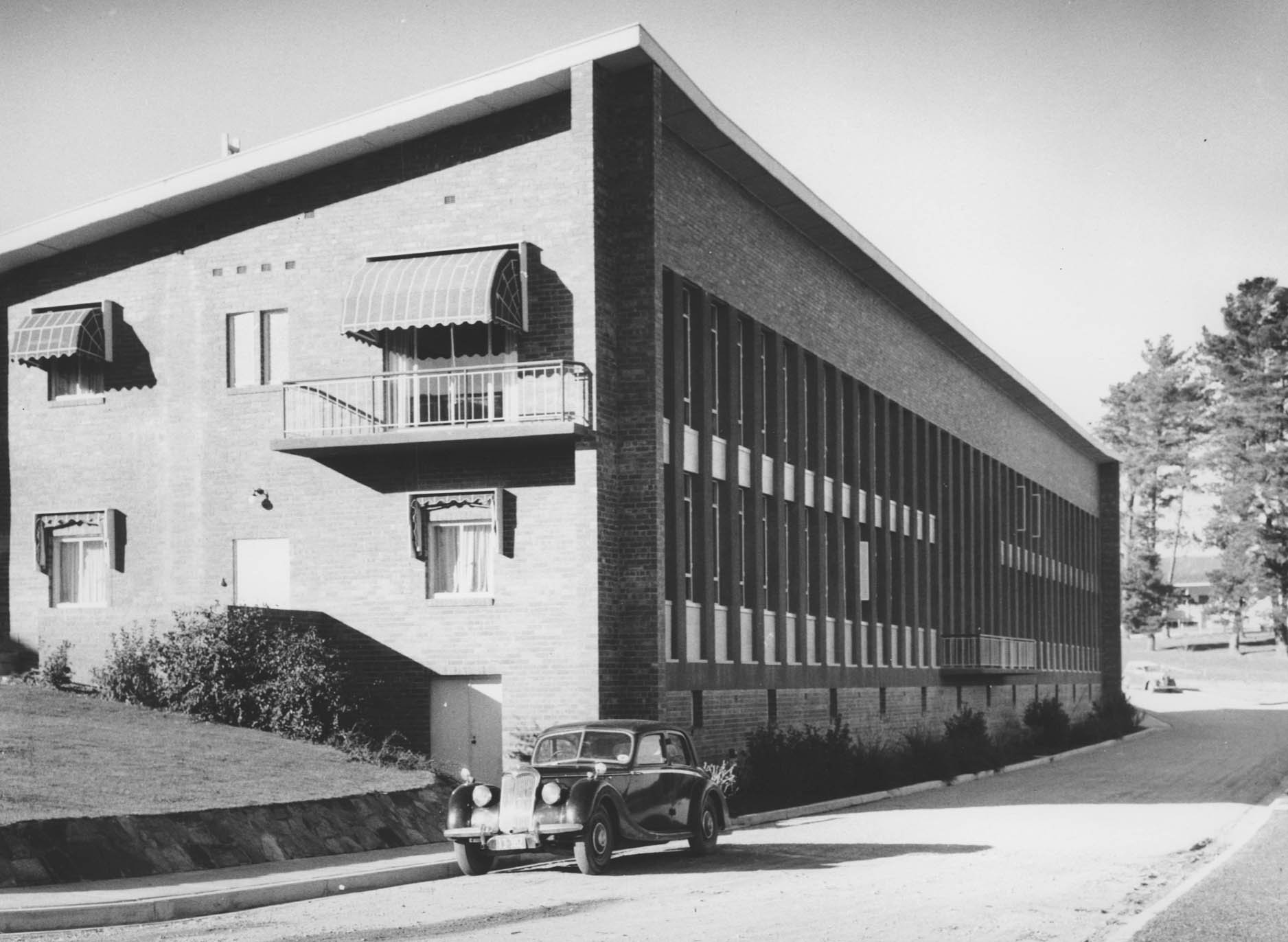Building Highlight - Research School of Physical Sciences and Engineering Buildings
The Research School of Physics and Engineering (RSPE), known originally as the Research School of Physical Sciences (RSPhysS), was the ‘pioneer school’ of the University and one of the first research schools established on the ANU campus.
In 1948 Sir Marcus Oliphant was appointed Director of the RSPhysS and preparations for the construction of the laboratories began soon afterwards. The RSPhysS Buildings were the first completed permanent buildings on the Acton Campus.
Amongst the buildings comprising the School are the following: Cockcroft Building, Le Couteur Building, Oliphant Building, Applied Mathematics Building, Leonard Huxley Building, Nuclear Physics Building, Heavy Ion Accelerator Facility, Erich Weigold Building, John Carber Building and Cockroft Oliphant Link Building.
Cockcroft Building
The Cockcroft Building (Laboratory Block) was the first completed section of the RSPhysS complex and was opened by Sir John Cockcroft, one of the world’s foremost nuclear physicists, on 5 September 1952. Also in attendance at the opening ceremony were Prime Minister Robert Menzies; Leader of the Federal Opposition, Dr H.V. Evatt; Director of the School of Physical Sciences, Professor Mark Oliphant; and Vice-Chancellor of the ANU, Sir Douglas Copland.
The building was designed by Professor Brian Lewis, the inaugural University Architect, with the foundation stone laid by Prime Minister Ben Chifley in October 1949.
The building was named after Sir John Cockcroft, a British physicist who shared with Ernest Walton the Nobel Prize in Physics in 1951 for splitting the atomic nucleus, and who was instrumental in the development of nuclear power.
Le Couteur Building
The Le Couteur Building, originally known as the Mathematical Sciences Building, was designed by Buchan, Laird and Buchan Pty Ltd, with construction undertaken between 1961 and 1963. Later extensions to the building were undertaken in 1971 and 2005-06.
In 1996 the building was renamed the Le Couteur Building, a tribute to theoretical physicist Kenneth Le Couteur. Le Couteur was internationally recognised for his work, including his role as a codebreaker at Bletchley Park during the Second World War. In 1956 he was appointed as Foundation Professor of Theoretical Physics in the Research School of Physical Sciences at the ANU, a position he held until retirement in 1985. Under his guidance the Department earned an international reputation for its research. He was also instrumental in introducing the use of computing within the ANU. Le Couteur served as Acting Director of the Research School of Physics in 1973-74 and 1978.
Oliphant Building
The foundation stone for the Oliphant Building was laid by Prime Minister Ben Chifley in October 1949, with the official opening in 1952.
The building was originally named the Chifley Building in honour of Prime Minister Ben Chifley, but with the decision to rename the General Studies Library the JB Chifley Library, the building was renamed the Oliphant Building in 1970.
The new name was in honour of Sir Marcus Oliphant, whose contribution to the development of the ANU and indeed, to scientific teaching and research in Australia, can hardly be overstated. Oliphant was a member of the ANU Interim Council and the Foundation Director of the Research School of Physical Sciences. In addition to leading work in high-energy accelerator physics, Oliphant, as Director, expanded the work of the School to include astronomy, mathematics, geophysics, theoretical physics, atomic and molecular physics, nuclear physics and particle physics and under his leadership, the School became a major centre for Australian research and postgraduate training in the physical sciences (Carver et al 2000).
A link building between the Oliphant and Cockcroft Buildings was constructed in 1990, designed by Collins Caddaye Architects.
Leonard Huxley Building
Designed by O’Mahony, Neville and Morgan in association with Tom Brown and Associates in 1975, the Leonard Huxley Building was originally known as the Computer Services Centre and Solid-State Physics Building.
In June 1987 the building was renamed the Leonard Huxley Building, and was home to the Division of Information Administration Programs and the ANU Supercomputer Facility.
Sir Leonard George Holden Huxley was a physicist who worked with the Radio Research Board, an adjunct to the Council for Scientific and Industrial Research (CSIR, later CSIRO). Huxley spent much of his early career in England before returning to Australia to take up the Sir Thomas Elder Chair of Physics at the University of Adelaide in 1949. In 1960 Huxley was appointed to the executive of the CSIRO, but a short time later he was invited to take up the position of Vice-Chancellor of the ANU. Huxley served as Vice-Chancellor from 1960 to 1967 and oversaw an enormous period of growth for the ANU. Huxley was also a foundation fellow of the Australian Academy of Science and served on its council (1956-62) and as Vice-President (1957-58).
Applied Mathematics Building
The Applied Mathematics Building was originally designed to house the Department of Geophysics in 1951, with the design produced by architects Kenneth Oliphant and Professor Brian Lewis.
The original building consisted of an elongated workshop and laboratory building, and a double-storey annex attached to the centre of the northern façade for the preparation of rock slides. A boiler house was added to the east of the central annex, and an insulated room added in the basement for thermal measurements. Further extensions to the building were undertaken in 1952 and 1953, designed by Harry Divola. These extensions included additional laboratories and offices as well as a new wing with a courtyard that overlooked the racecourse and Molonglo River, later inundated by Lake Burley Griffin.
The Department, under the leadership of Professor John Jaeger, rapidly expanded and outgrew the space. Rather than agreeing to the requested additional extensions to the building, the University Council instead relocated the School to a more permanent home in the new Jaeger Building in the late 1960s.
After some alterations, the building became home to the Department of Applied Mathematics in 1971.
References
Godden Mackay Logan Heritage Consultants 2012, ANU Heritage Study: Acton Campus. Volume 1: Heritage Study, https://services.anu.edu.au/files/document-collection/Volume_1_of_the_ANU_Acton_Campus_Heritage_Study.compressed.pdf











